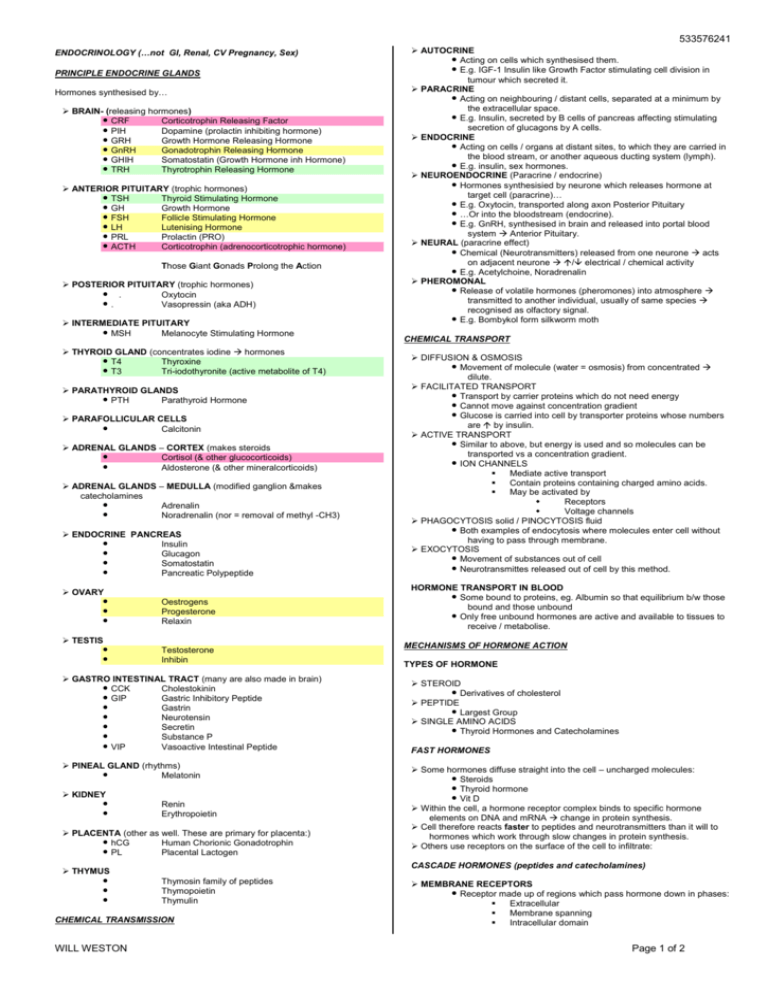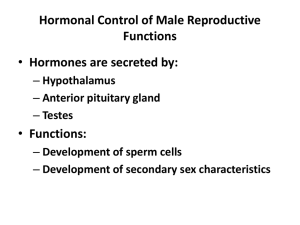response of target cell to hormone
advertisement

533576241 ENDOCRINOLOGY (…not GI, Renal, CV Pregnancy, Sex) PRINCIPLE ENDOCRINE GLANDS Hormones synthesised by… BRAIN- (releasing hormones) CRF Corticotrophin Releasing Factor PIH Dopamine (prolactin inhibiting hormone) GRH Growth Hormone Releasing Hormone GnRH Gonadotrophin Releasing Hormone GHIH Somatostatin (Growth Hormone inh Hormone) TRH Thyrotrophin Releasing Hormone ANTERIOR PITUITARY (trophic hormones) TSH Thyroid Stimulating Hormone GH Growth Hormone FSH Follicle Stimulating Hormone LH Lutenising Hormone PRL Prolactin (PRO) ACTH Corticotrophin (adrenocorticotrophic hormone) Those Giant Gonads Prolong the Action POSTERIOR PITUITARY (trophic hormones) . Oxytocin . Vasopressin (aka ADH) INTERMEDIATE PITUITARY MSH Melanocyte Stimulating Hormone THYROID GLAND (concentrates iodine hormones T4 Thyroxine T3 Tri-iodothyronite (active metabolite of T4) PARATHYROID GLANDS PTH Parathyroid Hormone PARAFOLLICULAR CELLS Calcitonin ADRENAL GLANDS – CORTEX (makes steroids Cortisol (& other glucocorticoids) Aldosterone (& other mineralcorticoids) ADRENAL GLANDS – MEDULLA (modified ganglion &makes catecholamines Adrenalin Noradrenalin (nor = removal of methyl -CH3) ENDOCRINE PANCREAS Insulin Glucagon Somatostatin Pancreatic Polypeptide OVARY Oestrogens Progesterone Relaxin TESTIS Testosterone Inhibin GASTRO INTESTINAL TRACT (many are also made in brain) CCK Cholestokinin GIP Gastric Inhibitory Peptide Gastrin Neurotensin Secretin Substance P VIP Vasoactive Intestinal Peptide PINEAL GLAND (rhythms) Melatonin KIDNEY Renin Erythropoietin PLACENTA (other as well. These are primary for placenta:) hCG Human Chorionic Gonadotrophin PL Placental Lactogen Thymosin family of peptides Thymopoietin Thymulin CHEMICAL TRANSMISSION WILL WESTON CHEMICAL TRANSPORT DIFFUSION & OSMOSIS Movement of molecule (water = osmosis) from concentrated dilute. FACILITATED TRANSPORT Transport by carrier proteins which do not need energy Cannot move against concentration gradient Glucose is carried into cell by transporter proteins whose numbers are by insulin. ACTIVE TRANSPORT Similar to above, but energy is used and so molecules can be transported vs a concentration gradient. ION CHANNELS Mediate active transport Contain proteins containing charged amino acids. May be activated by Receptors Voltage channels PHAGOCYTOSIS solid / PINOCYTOSIS fluid Both examples of endocytosis where molecules enter cell without having to pass through membrane. EXOCYTOSIS Movement of substances out of cell Neurotransmittes released out of cell by this method. HORMONE TRANSPORT IN BLOOD Some bound to proteins, eg. Albumin so that equilibrium b/w those bound and those unbound Only free unbound hormones are active and available to tissues to receive / metabolise. MECHANISMS OF HORMONE ACTION TYPES OF HORMONE STEROID Derivatives of cholesterol PEPTIDE Largest Group SINGLE AMINO ACIDS Thyroid Hormones and Catecholamines FAST HORMONES Some hormones diffuse straight into the cell – uncharged molecules: Steroids Thyroid hormone Vit D Within the cell, a hormone receptor complex binds to specific hormone elements on DNA and mRNA change in protein synthesis. Cell therefore reacts faster to peptides and neurotransmitters than it will to hormones which work through slow changes in protein synthesis. Others use receptors on the surface of the cell to infiltrate: CASCADE HORMONES (peptides and catecholamines) THYMUS AUTOCRINE Acting on cells which synthesised them. E.g. IGF-1 Insulin like Growth Factor stimulating cell division in tumour which secreted it. PARACRINE Acting on neighbouring / distant cells, separated at a minimum by the extracellular space. E.g. Insulin, secreted by B cells of pancreas affecting stimulating secretion of glucagons by A cells. ENDOCRINE Acting on cells / organs at distant sites, to which they are carried in the blood stream, or another aqueous ducting system (lymph). E.g. insulin, sex hormones. NEUROENDOCRINE (Paracrine / endocrine) Hormones synthesisied by neurone which releases hormone at target cell (paracrine)… E.g. Oxytocin, transported along axon Posterior Pituitary …Or into the bloodstream (endocrine). E.g. GnRH, synthesised in brain and released into portal blood system Anterior Pituitary. NEURAL (paracrine effect) Chemical (Neurotransmitters) released from one neurone acts on adjacent neurone / electrical / chemical activity E.g. Acetylchoine, Noradrenalin PHEROMONAL Release of volatile hormones (pheromones) into atmosphere transmitted to another individual, usually of same species recognised as olfactory signal. E.g. Bombykol form silkworm moth MEMBRANE RECEPTORS Receptor made up of regions which pass hormone down in phases: Extracellular Membrane spanning Intracellular domain Page 1 of 2 533576241 Intracellular domain may be linked with antoher membrane protein system- GTPases SECOND MESSENGERS Hormone e.g. Adrenalin binds to receptor activates a membrane G protein G proteins are GDP (guanosine diphosphate) in inactive state but GTP when active. Subunit of GTP then cuases adenylate cyclase ATP cAMP (cyclic adenosine mono phosphate) [THE SECOND MESSENGER] cAMP then goes on to activate protein kinase, which in turn goes on in a cascade resulting in a cellular response. Each hormone can result in production of many cAMP molecules => AMPLIFIES RECEPTOR / HORMONE INTERACTION. Some hormones may produce inhibitory effects on cell E.g. Noradrenalin inhibits formation of adenylate cyclase formation fo cAMP RESPONSE OF TARGET CELL TO HORMONE Depends on Hormone concentration Abundance of target cell hormone receptors Influences exerted by other hormones PERMISSION EFFECT Upregulates receptors Promotes synthesis of enzyme required for exporession SYNERGISTIC EFFECT Oocyte development needs FSH and Oestrogen ANTAGONISTIC EFFECT Insulin glycogen systhesis Glucagon glycogen breakdown Growth Hormone is a peptide hormone Secreted by somatotrophs from Anterior Pituitary Secretion shows a circadian rhythm with the highest levels occurring during Non REM sleep. ACTIONS ON BODY Protein synthesis Insulin action Glucose sparing by uptake of glucose Lypolysis of adipose tissue Providing non carbohydrate source for ATP Most important stimulus is hypoglycaemia Also stimulated by Plasma levels of amino acids Plasma levels of free fatty acids Skeletal growth from 3 puberty Maintains tissue in adulthood. Skeletal growth occurs in response to somatomedins stimulated by GH Cartilage division & enhances deposition In localised Insulin like growth factors (IGF) from liver Aids bone differentiation Increase rate of cell division in many cells. Sleep Exercise Stress Hypothalamus GHRH Somatostatin NEURO-ENDOCRINE ANATOMY OF HYPOTHALAMUS AND PITUITARY GLAND Anterior Pituitary HYPOTHALAMUS: located in the middle of the base of the brain, and encapsulates ventral portion of third ventricle. PITUITARY GLAND (aka Hypophysis): Lies immediately beneath hypothalamus, resting in depression of base of the skull called sella turcica ("Turkish saddle"). GH Magnocellular Neurosecretory System Parvocellular Neurosecretory System HYPOTHALAMUS GnRH Medial Pre Optic Nucleus CRF Body- See above Liver IGF-1 PINEAL GLAND TRH Attached to roof of 3rd brain ventricle Gland secretes MELATONIN derived from Seratonin. Synthesis in darkness and during day. Light retina Sympathetic nerve activity Pineal Gland. Allowing for synchronisation of circadian rhythm Para Ventricular Nucleus Hypothalmo-Hypophyseal Tract THYMUS Supra Optic Nucleus Located posterior to sternum in b/w lungs Secretes THYMIC HORMONAL FACTOR (THF) THYMIC FACTOR …Maturation of T cells may retard aging process. Inbetween is grey swelling which tapers to form INFUNDIBULUM aka Pituitary Stalk aka Median Eminence INTERLEUKINS Arcuate Nucleus Infundibulum CRF GnRH TRH Somatostatin GHiF Neurotensin Dopamine PRL GRH Somatostatin Pituitary Stalk ANTERIOR PITUITARY aka Adenohypophysis Portal Upward growth from oral System cavity Oxytocin & ADH POSTERIOR PITUITARY aka Neurohypophsis Downward growth from hypothalamus Family of proteins derived from leukocytes. Examples of cytokines (soluble intercellular communicators) IL1 Produced by activated macrophages Stimulates IL2 production IL2 Produced by T cells during an activated immune response Stimulates B cell proliferation and differenciation IL6 An interferon Beta Produced by fibroblasts and some tumour cells immunoglobin synthesis and has antiviral activity GASTRO INTESTINAL HORMONES from at a glance new Catecholanines from at a glance? Insulin Ash GROWTH HORMONES WILL WESTON Renin agiontensin Page 2 of 2








